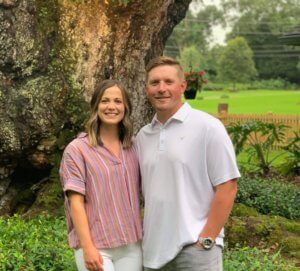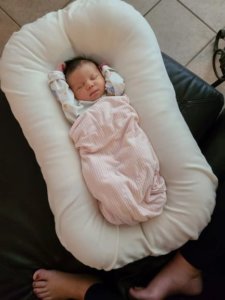Couple endures many doctors, numerous treatments and countless negative pregnancy tests on their quest for a family.
 Heather and Tyler of Lafayette, LA, were awarded the Gift of Hope IVF Grant 2020.
Heather and Tyler of Lafayette, LA, were awarded the Gift of Hope IVF Grant 2020.
From the beginning of their relationship, Heather and Tyler, both now in their early thirties, knew there was one thing their future held – a family. “Two, three, maybe four kids,” recalls Heather. “We dreamed of all the things: their names, who they might look like, what schools we would send them to.”
Heather, who works as an exercise physiologist, says that as soon as they got married over five years ago they immediately started trying to get pregnant. She remembers being excited and terrified at the same time on the first day she went without birth control. “We thought for sure, a month, maybe two, and I’d be pregnant that quickly,” says Heather. They both had no idea they would be in for a long, difficult and costly journey.
Their 5-year infertility journey created more heartache than they were ever prepared for.
After trying on their own for a year, Heather couldn’t believe it when she got a faint, but positive pregnancy test. “We planned a big announcement for our families, but the day after telling them I knew something wasn’t right,” says Heather. This pregnancy ended in a miscarriage and surgery to remove a cyst on her ovary.
Between then and late 2017, the Lafayette couple sought treatment with fertility drugs and timed intercourse. When those efforts failed, they decided to meet with Dr. John Storment who recommended intrauterine insemination, IUI, to treat their unexplained infertility. Heather and Tyler were certain this treatment would finally give them a baby. But after this procedure also failed to produce a pregnancy, they were frustrated.
By now, the couple had close to three years of failed pregnancy tests. Looking for answers, they followed the advice of two close friends who were also struggling with infertility who recommended an OBGyn in town who had helped them. This doctor ordered new lab work and laparoscopic surgery to remove “anything and everything unhealthy.” This was the cure, so they thought. But months went by and still no pregnancy.
Heather and Tyler soon found their way back to Dr. Storment who recommended they continue with IUI given their diagnosis with unexplained infertility. But after three more rounds of IUI with no results, they were again frustrated. “Everything looked good for us to conceive. It just didn’t make any sense that it didn’t work,” says Heather.
Unexplained infertility is often difficult to treat when there is no medical condition to link the inability to conceive to.
At this point Dr. Storment recommended in vitro fertilization, IVF, but the couple was reluctant. “IVF has always been scary for us,” says Heather. “Because of our diagnosis of unexplained infertility, we just felt that our infertility wasn’t real. There was no medical problem that we could tie our inability to get pregnant back to. Opting for IVF would make our infertility more real, and that was hard for us to accept.”
Then another friend recommended a doctor in Alabama who was offering a new, lower cost version of IVF called INVOcell. This relatively new procedure uses less medication and lab expertise. In this procedure, the incubation of the embryos takes place in a small jar placed inside the vagina for five days. Originally created for third world countries lacking sophisticated embryology labs, the procedure is lower in cost than traditional IVF, but success rates are markedly lower too.
“We don’t offer INVOcell to our patients because of this,” says Dr. Storment. He notes that the procedure results in significantly fewer embryos and a higher percentage of canceled cycles that can erase any cost savings. Additionally, because the embryologist can’t monitor what is happening during the early stages of embryo development, that information is lost. “Ideally, we want IVF to shed more light on the cause of infertility, not less,” added Dr. Storment.
Nonetheless, Heather and Tyler were intrigued based on their friend’s success and began travelling back and forth to Alabama for the treatment.
Over the next year they would do two rounds of INVOcell, both of which failed. After this, they switched to a new OBGyn who put them through several more months of fertility medications which also failed. At this low point in their fertility journey, nearing the end of their options and finances, their hope seemed crushed. Maybe a family would never happen for them. Just the thought of this literally made Heather’s stomach hurt.
It is at this point that Heather and Tyler returned to Fertility Answers to discuss moving forward with IVF. That’s when they discovered they were also eligible to apply for the Gift of Hope IVF Grant 2020 program. Their Gift of Hope IVF Grant also includes genetic screening of their embryos with preimplantation genetic testing, PGT-A, donated by Fertility Answers lab partner Ovation Fertility.
 “We are so incredibly grateful for everything Fertility Answers has done for us over the years and for being chosen for the Gift of Hope IVF grant 2020,” says Heather. “We hope that it will lead us to the family we’ve dreamt and prayed for, for so long. This journey has been so difficult on us mentally, physically, emotionally and financially. We will continue to keep our hopes high until our prayers are answered.”
“We are so incredibly grateful for everything Fertility Answers has done for us over the years and for being chosen for the Gift of Hope IVF grant 2020,” says Heather. “We hope that it will lead us to the family we’ve dreamt and prayed for, for so long. This journey has been so difficult on us mentally, physically, emotionally and financially. We will continue to keep our hopes high until our prayers are answered.”
UPDATE: Heather and Tyler became parents at long last – baby Ann Riley was born in June 2021!



